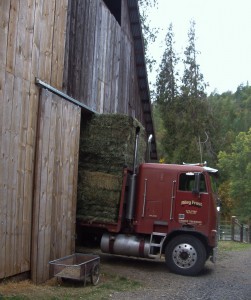Got hay for your Soay sheep?
The realization that lambing starts in five weeks sent Steve out to the barn today to count what’s left of our winter hay supply. Do we have enough to last until the pastures green up? When we put in our order last summer for winter hay, we factored in the extra needed for gestation and nursing, but the thought of running out is so scary that Steve ran the “are we sure” count again. I would like to say we always remember to check about this time each year, but without reminders in the datebook, the final pre-lambing hay supply check might get lost in the shuffle.
We buy enough for November through April, more or less. The grass is getting pretty crummy by the end of September, but hay is so expensive that we let the heep scrounge the remaining grass in the fields for as long as we can. And when we put our breeding groups together in late October, we can’t rotate the sheep any more so we have to turn to hay. In terms of the end of hay season, some years we have lush fields by mid-March, some years it’s a little later depending on when the ground warms up. The hay keeps pretty well so we err on the side of having a few bales left over. Last-minute orders of hay in February can really poke a big hole in your Soay sheep budget. This year, both the Capital Press and our local paper report that for all intents and purposes, there is no hay left to be bought. Southern Californians suffering through drought apparently bought up all the extra Oregon hay.
The formula we use is one we heard about in a seminar on pasture management run by Woody Lane, who by the way knows more about grass and how to maximize pastures than anyone we’ve come across. To calculate the amount of hay you’ll need, start by assuming pounds of hay at 5% of body weight per day per animal. We use 55 pounds as our ewe weight, 75 pounds as our ram weight, and 40 pounds as the weight of our lambs born the prior spring. So for a lamb, .05 x 40 = 2 pounds of hay per day. If you’ve remembered to ask your hay supplier for an average bale weight, you can easily calculate how many bales you need.
From watching our pregnant ewes the last couple of years, we estimate they eat about 1.5 times as much during the last month of gestation and easily twice as much while they are lactating (nursing). But by the time they are nursing, the rams and the non-pregnant ewes are converting from hay to spring grass in the pastures, so with these offsetting factors, the original 5% calculation is sufficient. These numbers worked well last year and based on our bale count this afternoon, they’re holding steady this year as well.
More on how we choose our hay later.
For now …

I have found
over the years that no matter what animal or bird, weather makes a
difference in how much I feed. When the weather is cold, very cold all
of the animals need more to eat as they are expending so much of their
energy staying warm. So rather than have a set formula that I use I
would use a baseline, but base that on temp. In really warm weather
they will eat much less.
Thanks for the heads-up about the need for more fuel for our Soay in cold weather. Do you have any benchmarks you can pass along, such as a temperature below which you add __ more flakes, or __% more hay, or anything like that? And how about the other end, when it gets really hot, any way to judge how much to cut back other than hunch based on your years of experience?